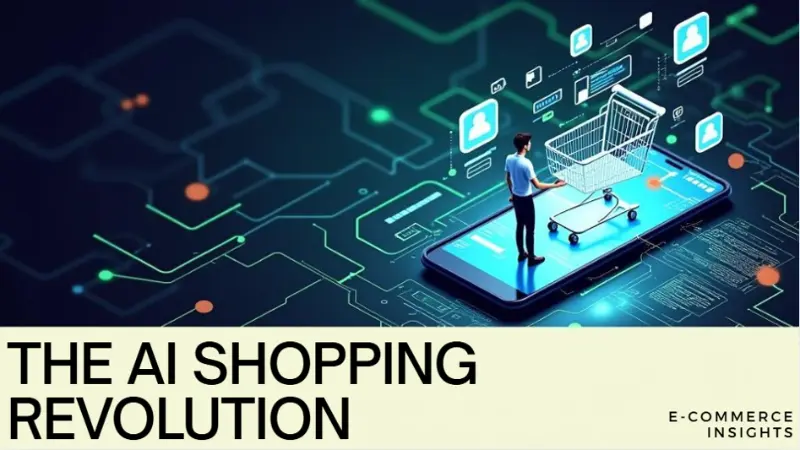AI Shopping Assistant Revolution: Shopify’s Big Bet on Agentic Commerce

Last updated on August 21, 2025

In this article
 11 minutes
11 minutes
Why AI Shopping Agents Are Suddenly Everywhere
Just a couple of years ago, “AI shopping assistant” sounded like a gimmick. Today, it’s feeling like the future of online shopping. Shopify’s latest earnings blew past expectations (31% revenue growth year-over-year), and the company’s leadership credited much of that success to investments in AI-powered shopping. In Shopify’s Q2 2025 call, president Harley Finkelstein talked up “agentic commerce” as the next big thing, saying Shopify’s unique position with brands gives it an edge in this emerging online retail industry. In plain English: AI shopping assistants and AI agents are moving from tech demo to core business driver. And the results are already showing up in Shopify’s bottom line.
From my perspective, this isn’t just Shopify hyping new tools; it’s a sign of a broader shift in how shoppers and retailers interact. AI agents (essentially smart algorithms often powered by large language models like GPT-5) can now handle tasks that used to require a human. They can track price drops, compare features across dozens of products, answer detailed questions about specs or reviews, and even complete purchases on behalf of a user. All automatically. We’re witnessing the rise of the agentic AI era, where consumers might simply tell their phone or smart assistant, “Find me the best budget 4K TV and buy it,” and an AI agent does the rest. That might have sounded sci-fi, but Shopify’s saying it’s just about here.
Slash Your Fulfillment Costs by Up to 30%
Cut shipping expenses by 30% and boost profit with Cahoot's AI-optimized fulfillment services and modern tech —no overheads and no humans required!
I'm Interested in Saving Time and MoneyShopify’s AI Playbook: Building the Agentic Commerce Infrastructure
Shopify isn’t sitting around. They’re actively opening the door for these AI shopping agents to drive sales on their platform. In fact, Shopify just rolled out a comprehensive suite of tools enabling AI agents to execute complete shopping transactions. Let’s break that down:
- Shopify Catalog – A giant database that lets AI agents instantly search hundreds of millions of products with real-time inventory and pricing. Basically, an AI assistant can see what’s in stock across Shopify’s network and at what price, so it knows where to find the best deal or quickest ship time for you.
- Universal Cart – This one blew my mind a bit. It lets an AI agent hold items from multiple different stores in one cart. Imagine you’re chatting with a generative AI shopping bot that recommends a shirt from one Shopify store and sneakers from another. Normally, you’d have to check out twice. But with Universal Cart, the AI can lump them together and handle all the complexity in the background. One shopping journey, one checkout, even though the products are from different businesses.
- Checkout Kit – The final piece: when it’s time to buy, the AI agent can seamlessly initiate the purchase through each store’s checkout flow, while keeping the experience within the assistant interface. In practice, that means the end customer doesn’t feel like they left the chat or app to go fill out forms on a website. The AI handles it, maintaining the assistant’s “branding” or interface. Smooth.
Shopify basically built the plumbing so that any AI, whether it’s Shopify’s own assistant, or a third-party AI agent like something running on Google’s Gemini or OpenAI, can plug into Shopify stores and transact. It’s a bold move to position Shopify as the behind-the-scenes infrastructure for AI-driven shopping. Harley Finkelstein even said Shopify’s ahead because of their relationships with AI companies (they’ve partnered with OpenAI and others). The message: if brands want their products found and purchased by the coming wave of AI assistants, they need to be on platforms (like Shopify) that are ready for it.
And it’s not just Shopify. Amazon and Walmart are experimenting with their own AI shopping solutions. (Amazon recently piloted a “Buy for Me” feature where their app’s AI will literally purchase items from other websites for you, wild.) The future of e-commerce might not be customers browsing websites at all; it could be AI agents doing the browsing based on our preferences and instructions. Consumers might simply say what they want, and AIs will do the searching, vetting, and buying.
Looking for a New 3PL? Start with this Free RFP Template
Cut weeks off your selection process. Avoid pitfalls. Get the only 3PL RFP checklist built for ecommerce brands, absolutely free.
Get My Free 3PL RFPA New Type of Customer Experience, Powered by AI
If you’re wondering why anyone would use an AI agent instead of going to a store website or app themselves, here’s the appeal: efficiency and personalization. A good AI shopping assistant can instantly filter through thousands of options across the web, taking into account your specific preferences, past purchases, and even pulling in reviews or expert data. It’s like having a personal shopper who knows everything about every product ever made, available 24/7. Busy buyers love anything that saves time and makes life easier. If an AI can find the exact product that fits my needs (cheapest price, highest rated, arriving tomorrow), why would I slog through multiple websites and read endless reviews myself?
These agents can also answer questions in real time, “Does this laptop support 32GB RAM? What’s the return policy? Is there a warranty?”, without me having to dig through FAQ pages. They can compare and find products that meet very specific criteria (e.g., “find me a dining table under $500 that’s solid wood and has at least 4-star reviews”). That’s a level of service traditional search or e-commerce interfaces haven’t delivered. Generative AI and LLMs are making the experience more conversational and human-like. It feels less like using a search engine and more like chatting with a super knowledgeable sales associate.
However, this shift has huge implications for brands and online retailers. If customers start delegating their purchase decisions to AI agents, the online shopping experience changes fundamentally. Product recommendations might be coming from an algorithm that doesn’t care about flashy marketing; it cares about data and facts. That’s a bit of an AI retail paradox: on one hand, AI-driven personalization can boost customer satisfaction by surfacing exactly what people want; on the other hand, it could disrupt the traditional notions of brand loyalty and impulse buying. Consumers might rely on cold, hard facts from an AI (specs, price, reviews) more than brand image or emotional ads. As an industry colleague of mine noted, things like emotional ad copy and lifestyle photos may lose punch, while verifiable data on materials and performance become more critical. In a world of AI agents, your product descriptions, specs, and reviews (essentially, your data) matter more than shiny marketing.
Another consideration: secure shopping experiences. AI agents will need access to a lot of information to do their jobs, including product feeds, inventory levels, and maybe even your past purchase history (if you allow it). Platforms like Shopify are focusing on ensuring these integrations are secure and privacy-compliant. Trust is key: both retailers and shoppers need to trust the AI systems. Shopify has even tweaked its code to manage how third-party AI scrapers or bots interact with stores, likely to prevent abuse while still enabling genuine assistants. It’s a delicate balance of opening up for new opportunities (AI-driven sales) without losing control of the customer relationship.
What It Means for Retailers and Brands
So, what should business owners and brand operators take away from this? I see a few immediate action items:
1. Optimize Your Product Data for Machines: In the same way we all learned about SEO (Search Engine Optimization) to rank on Google, now we have to think about “AEO” – AI Engine Optimization. AI shopping agents don’t “see” your pretty web design; they consume your data. Are your product titles, descriptions, specs, pricing, and stock info easily readable by a machine? Are they comprehensive and accurate? If your listings aren’t structured for machine readability, you’ll be invisible to these assistants. This might mean adopting structured data standards, improving your product information management, and syncing inventory in real-time. Brands should audit their catalogs and ensure everything from size dimensions to materials to customer ratings are correctly exposed. An AI can’t appreciate your lifestyle imagery – it’s parsing text and numbers. Make those count.
2. Embrace AI Tools Yourself: Just as consumers will use AI, brands can leverage AI-powered tools on their end. For example, AI can help write better product descriptions (tailored to what consumers ask about), manage customer service chats via chatbots, and analyze customer behavior patterns to see what factors influence purchase decisions. Many ecommerce businesses are already using AI for things like dynamic pricing, personalized email marketing, and inventory forecasting. These improve the shopping journey for customers (through more relevant recommendations, etc.) and improve operations for you (through efficient stock management and pricing). If your competitors are using AI to create a smoother shopping online experience and you’re not, you’ll fall behind.
3. Prepare for New Customer Journeys: The purchase decisions of the near future might not involve a customer slowly meandering through a site and adding things to the cart. It could be an AI agent presenting 2 options to the customer for instant approval. Or an AI just orders refills of a product for a subscriber without them even asking (based on preset preferences). Retailers need to anticipate these flows. That could mean focusing more on subscription models, direct integrations with assistant platforms, or ensuring your brand is recommended by the algorithms (possibly via great reviews, or partnerships, or by having unique products an AI can’t find elsewhere). It’s a new kind of marketing: instead of appealing solely to consumers, you’re also appealing to the logic of AI systems. For instance, if sustainability or warranty length becomes a key attribute that AIs consider (because consumers expect those factors), brands might highlight those more. I’m curious which product attributes will matter most to the “AI shoppers”; it could be sustainability, warranty, reviews, origin, etc., as speculated by industry observers.
4. Don’t Ditch the Human Touch: Even as technology takes over routine interactions, there’s still a role for human-centric branding and community. AI assistants might handle transactions, but brand discovery can still happen through content, social media, and real-world experiences. Smart retailers will use AI for what it’s good at (speed, data-crunching, automation) while continuing to invest in brand storytelling and customer relationships. The end customer ultimately benefits from AI efficiency, but they’ll still connect with brands that stand for something relatable. In short, let AI handle the tedious stuff so you can focus on higher-level value and creativity.
Scale Faster with the World’s First Peer-to-Peer Fulfillment Network
Tap into a nationwide network of high-performance partner warehouses — expand capacity, cut shipping costs, and reach customers 1–2 days faster.
Explore Fulfillment NetworkConclusion: Adapting to an AI-Driven Commerce Era
The rise of AI shopping assistants is not a far-off fantasy; it’s here, and it’s accelerating. Shopify’s big bet on agentic commerce is a wake-up call across the commerce space. They’re effectively saying: the way people shop online is evolving, and Shopify intends to be the backbone powering those AI-mediated experiences. For consumers, this promises more personalized, efficient shopping journeys where an AI does the heavy lifting of finding deals and making sense of endless options. For retailers and brands, it means now is the time to ensure your data and systems are ready for algorithmic scrutiny. Embrace the change rather than fear it. Much like the early days of ecommerce itself, there will be winners and losers in this transition. The winners will be those who see AI not as a threat but as a tool, one that can create new opportunities for engagement and growth.
From secure shopping experiences and streamlined checkouts to AI-driven product recommendations, the pieces are falling into place for a new era of ecommerce. I won’t pretend there aren’t challenges (privacy, maintaining customer loyalty, and the sheer unpredictability of letting robots do the shopping). But one thing’s clear: online retail is headed into an AI-driven future, and it’s better to expect and prepare for it than play catch-up later. As Shopify’s leadership hinted, the brands whose products are “front and center” in AI workflows will have a huge advantage. It’s time to focus on that future now. The checkout bots are coming, and they might already have your site in their cart.
Frequently Asked Questions
What is an AI shopping assistant?
An AI shopping assistant is software that helps shoppers find products, compare prices, and make purchase decisions using generative AI and large language models.
How do AI shopping agents work?
They pull product data, reviews, and prices from retailers, then use AI to filter, rank, and recommend the best options based on customer preferences.
Why is Shopify betting on AI agents?
Shopify believes agentic AI commerce will dominate online shopping and is building tools like Catalog and Universal Cart to connect brands with AI-driven purchase decisions.
How will AI shopping assistants change online shopping?
They’ll make shopping faster and more personalized, offering product recommendations, price tracking, and even automated checkout.
How should retailers prepare for AI-driven shopping?
Retailers should optimize product listings with structured data, maintain strong reviews, and embrace AI-friendly platforms to stay visible to shopping agents.

Turn Returns Into New Revenue





